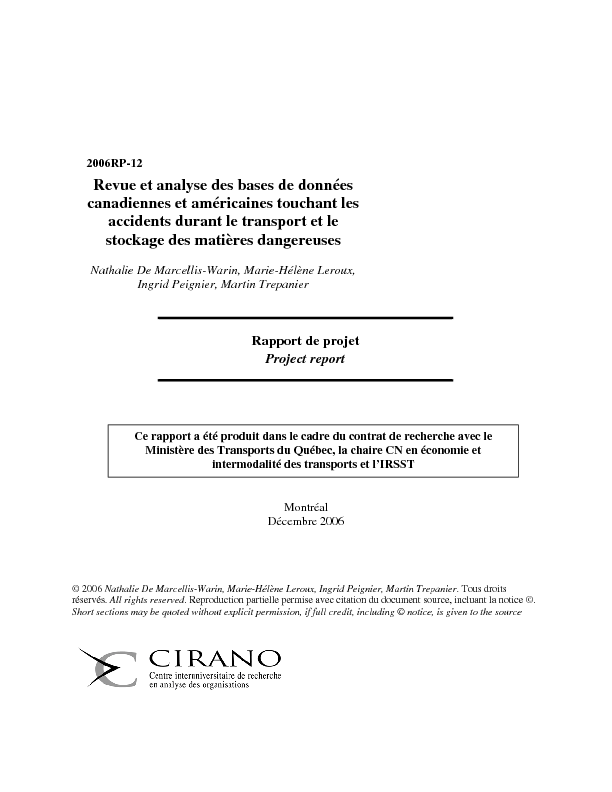Revue et analyse des bases de données canadiennes et américaines touchant les accidents durant le transport et le stockage des matières dangereuses
The transport of the dangerous goods is an important logistic activity in North America. Because of the nature of these goods, the regulation requires the report of the accidents occurring during their storage, their handling and their transport. These events can be reliable indicators of the risk inherent in the logistic activities related to dangerous goods.
Therefore this study presents a portrait of the existing databases concerning accidents during transport and storage of dangerous goods and a brief analysis of their contents. They will be mainly those of the Transport Ministry of Quebec (MTQ), of Transports Canada, of the Commission de la santé et de la sécurité du travail du Québec (CSST) and United States Department of Transportation. We emphasize on the accident types, the factors of causes of accident, the consequences. We try to carry out pairings between the various databases and to cross the data, which lead us to have a more complete portrait of the causes and consequences.
This study begins with an explanation of the principal basis supporting the review and the analysis of databases (chapter 1). Then, chapter 2 presents the various databases examined, while describing, when possible, the origin of this base, its methods of gathering, and its structure. Chapter 3 draws up a review of transport of dangerous goods in Canada and in the United States. Chapter 4 constitutes the analytical body of this work. It contains a compared analysis of principal databases concerning accidents in Quebec, Canada and United States. Chapter 5 (discussion and conclusion) comments on various aspects concerning the quality of the databases in order to make some recommendations to the different stakeholders.
The complete version of this publication is confidential.
NOTE
This research was carried out within the framework of the research project GLOBAL. The objective of the GLOBAL research project set up by INERIS (National Institute of the Industrial Environment and the Risks) in France is to develop a methodology to evaluate the risk of storage and transportation of dangerous goods.
Actually, industrial activity requires the production and the use of dangerous goods in the chemical plants. It also requires their transport between these installations. These products induce risks on the plants sites, but also between them, because of their transport. Today, regulations constrain on one hand chemical plants to minimise their risks and on the other hand the transport of dangerous goods. This is in this context that the present GLOBAL project will examine how the logistic strategies of the industrialists can influence the risks due to the transport of dangerous goods. For example, by minimising the quantities stored in the fixed installations, does one increase the risks due to transport and in this case, up to what extent? Thus the main objectives of the research are: first to examine new risks assessments methods in order top provide harmonised quantification of the chemical risks and to propose possible policies for the global decrease of risks.
The collaboration of the CIRANO and the École Polytechnique de Montréal to the GLOBAL project consist, on the one hand, of several operations performed jointly with INERIS (our team taking care of the application in Quebec of these operations):
It consist actually in trying to understand which are the costs associated with transport of dangerous goods and on the other hand understand the arbitration made by facilities in their logistic strategies, for example, transport versus storage but also in the choices of carriers, choice of itineraries, choice of transport mode, . We would like to measure the economic cost of the transport of the dangerous goods, to know the factors which influence the logistic choices (for example, necessary training of the workers, working conditions, history of accidents, comparison of the amount of CSST premium, reputation of the carriers, etc.) and to evaluate if the fact of having a total knowledge of the risk (storage and transport) and of its potential impacts would modify the global decisions.
The purpose is to study a few cases which might induce a transfer of risk from the fixed installations towards freight vehicles of dangerous goods, for example by decreasing the quantity stored in the fixed installations and by increasing the quantity stored temporarily in the bulks. It will consist in understanding the mechanisms of the transfer, judging their interest and their disadvantages, finding means of avoiding them if the disadvantages are significant, and then considering solutions of global management of the dangerous goods.
This report presents the operation C of the GLOBAL project, i.e. Review and analysis of Canadian and American databases concerning accidents during storage and transport of dangerous goods.




